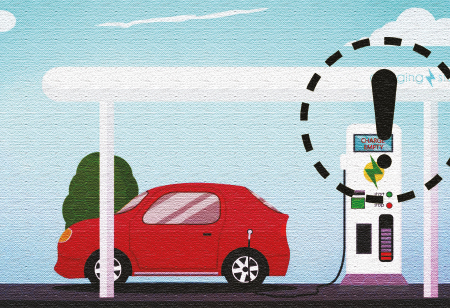With the country indulged in its biggest warfare againstpollution, all we see is roads laden with gas-guzzling vehicles that are contaminating the atmosphere and making it hard for us to breathe. The solution to this exigency lies in the adoption of electrically charged vehicles that would bring about a drastic reduction in the pollution levels of the country. India is pursuing on this unique pathway where the automobile industry is witnessing a revolution with the country trying hard to make a transition to electric vehicles. The government is continuously pushing towards an electric-vehicle future and is looking forward to make all the three-wheelers electric that are manufactured after 2023. But, with no proper infrastructure in place and higher operating costs, the future of EVs in India looks bleak and is being questioned by many industry experts.
According to a report published by The Ken, the electric two-wheelers that were sold in 2018 made up only 0.006 per cent of the total two-wheelers sold that year. This reluctance in the adoption of EVs can be subjected to several reasons like higher battery costs; heavy expenses and no charging stations which are keeping people away from investing in them. Furthermore, the problem with the battery supply and the dearth of skilled labour who have knowledge about the product adds more to the problem and is affecting the transition to EVs.
The Tough Road
As with a population of over 136.8 crores, the adoption of EVs in India will be much slower than that of China or the West. For India to become a “global hub of manufacturing of electric vehicles”, as mentioned by Nirmala Sitharaman in her budget, the government needs to mitigate through many challenges. Lack of charging infrastructure, no service centres, less vehicle mileage, lack of trained personnel, the problem of battery swapping and the high-rise cost of lithium-ion
batteries (LIB) are some of the issues prevailing in the EV sector that are preventing the widespread adoption of these electrically powered units. Moreover, with the non-availability of lithium and cobalt in the country, the manufacturing process becomes more costly, thus making the model a whole lot more expensive for an average Indian consumer than a conventional mainstream automobile. Even though the country can always import the metals needed for the battery but the aspect of buying these metals could have downstream affect due to the fact that the earth does not have enough of these metals plus the import tax will only add to the cost of the vehicle, thus, making people more repulsive against the EVs.
Electric vehicles have failed to make significant strides in the country given the high price tag and sparse charging stations but with the right policies and guidelines in place, a viable electric vehicle network can be built in place and accelerate the adoption of EVs by general public. For establishing an electric foothold in the world’s fourth largest automaker, the government also needs to come forward and fill the gaps in the EV ecosystem. As of now, the government is only providing subsidies in the commercial vehicle segment wherein the personal usage vehicles have been excluded. Be it bikes, cars or three-wheelers, the authorities have to step up actively in each segment to assist in the mass adoption of the electric automobile.
A complete phase-out of the internal combustion engines cars is a distant dream for India but with proper installation of an appropriate network of charging stations, the availability of subsidy schemes and cutting down the cost of batteries are some of the measures that can boost the electric mobility plans of the country and help us achieve an EV friendly future.
5 Initiatives Taken By Government to Drive the Growth Towards Electric Mobility:
• To promote the manufacturing and sale of EVs, the government launched a scheme, Faster Adoption and Manufacturing of Electric Vehicles (FAME) in 2015 which has now been extended to a second phase.
• In the recent Union Budget, a host of incentives were unveiled surrounding EVs where an exemption on custom duty on lithium cells ion was announced.
• NITI Aayog is looking forward to implement a policy according to which all ICE two-wheelers under 150cc will see a ban by 2025 and three-wheelers will be prohibited by 2023.
• Many states like Karnataka, Uttar Pradesh, Maharashtra, Delhi, Telangana and Kerala are individually working towards building a electric vehicle future.
• Recently, the government has also invited proposals from entities for the deployment of charging infrastructures.
